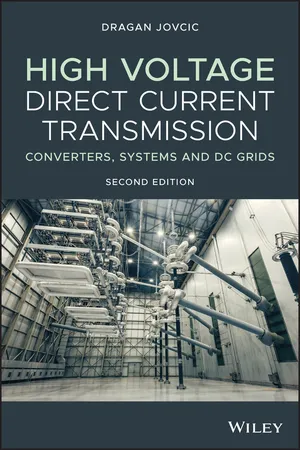
- English
- ePUB (mobile friendly)
- Available on iOS & Android
About This Book
Presents the latest developments in switchgear and DC/DC converters for DC grids, and includes substantially expanded material on MMC HVDC
This newly updated edition covers all HVDC transmission technologies including Line Commutated Converter (LCC) HVDC; Voltage Source Converter (VSC) HVDC, and the latest VSC HVDC based on Modular Multilevel Converters (MMC), as well as the principles of building DC transmission grids.
Featuring new material throughout, High Voltage Direct Current Transmission: Converters, Systems and DC Grids, 2nd Edition offers several new chapters/sections including one on the newest MMC converters. It also provides extended coverage of switchgear, DC grid protection and DC/DC converters following the latest developments on the market and in research projects. All three HVDC technologies are studied in a wide range of topics, including: the basic converter operating principles; calculation of losses; system modelling, including dynamic modelling; system control; HVDC protection, including AC and DC fault studies; and integration with AC systems and fundamental frequency analysis. The text includes:
- A chapter dedicated to hybrid and mechanical DC circuit breakers
- Half bridge and full bridge MMC: modelling, control, start-up and fault management
- A chapter dedicated to unbalanced operation and control of MMC HVDC
- The advancement of protection methods for DC grids
- Wideband and high-order modeling of DC cables
- Novel treatment of topics not found in similar books, including SimPowerSystems models and examples for all HVDC topologies hosted by the 1st edition companion site.
High Voltage Direct Current Transmission: Converters, Systems and DC Grids, 2nd Edition serves as an ideal textbook for a graduate-level course or a professional development course.
Frequently asked questions
Information
Part I
HVDC with Current Source Converters
1
Introduction to Line Commutated HVDC
1.1 HVDC Applications
- Submarine power transmission. AC cables have large capacitance and for cables over 40–70 km the reactive power circulation becomes unacceptable. This distance can be extended somewhat with reactive power compensation. For larger distances HVDC is more economical. A good example is the 580 km, 700 MW, ±450 kV NorNed HVDC between Norway and The Netherlands.
- Long‐distance overhead lines. Long AC lines require variable reactive power compensation. Typically 600–800 km is breakeven distance, and for longer distances HVDC is more economical. A good example is the 1360 km, 3.1 GW, ±500 kV Pacific DC intertie along the west cost of the USA.
- Interconnecting two AC networks of different frequencies. A good example is the 500 MW, ±79 kV back‐to‐back Melo HVDC between Uruguay and Brazil. The Uruguay system operates at 50 Hz whereas the Brazil national grid runs at 60 Hz.
- Interconnecting two unsynchronised AC grids. If the phase difference between two AC systems is large they cannot be directly connected. A typical example is the 150 MW, ±42 kV McNeill back‐to‐back HVDC link between Alberta and Saskatchewan interconnecting asynchronous eastern and western American systems.
- Controllable power exchange between two AC networks (for trading). The AC power flow is determined by the line impedances, and therefore the AC power flow cannot be directly controlled in each line. In complex AC networks it is common to observe loop power flow or even overloading or under‐utilisation of some AC lines. Many HVDC systems participate directly in trading power and one typical example is the 200 MW, ±57 kV Highgate HVDC between Quebec and Vermont.
Table of contents
- Cover
- Table of Contents
- Preface
- Part I: HVDC with Current Source Converters
- Part II: HVDC with Voltage Source Converters
- Part III: DC Transmission Grids
- Appendix A: Variable Notations
- Appendix B: Analytical Background to Rotating DQ Frame
- Appendix C: System Modeling Using Complex Numbers and Phasors
- Appendix D: Simulink Examples
- Index
- End User License Agreement